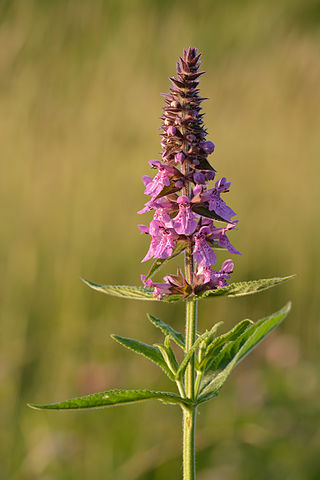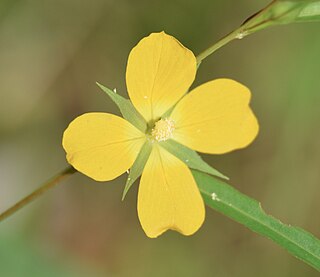
Alternanthera philoxeroides, commonly referred to as alligator weed, is a native species to the temperate regions of South America, which includes Argentina, Brazil, Paraguay and Uruguay. Argentina alone hosts around 27 species that fall within the range of the genus Alternanthera. Its geographic range once covered only the Parana River region of South America, but it has since expanded, having been introduced to over 30 countries, such as the United States, Japan, China, Australia, New Zealand and many more. This invasive species is believed to have been accidentally introduced to these non-native regions through sediments trapped by, or attached to, tanks and cargo of ships travelling from South America to these various areas.

Ludwigia is a genus of about 82 species of aquatic plants with a cosmopolitan but mainly tropical distribution.

Ludwigia hexapetala, the water primrose, is a herbaceous perennial plant of the family Onagraceae. Native to Central and South America, its habitat includes the margins of lakes, ponds, ditches, and streams. Its stems may be immersed or fully emergent. It is a noxious invader of aquatic ecosystems in North America.

Myriophyllum aquaticum is a flowering plant, a vascular dicot, commonly called parrot's-feather and parrot feather watermilfoil.

Stachys palustris, commonly known as marsh woundwort, marsh betony, clown's woundwort, clown's heal-all, marsh hedgenettle, or hedge-nettle, is an edible perennial grassland herb growing to 80 centimeters tall. It is native to parts of Eurasia but has been introduced to North America. The species epithet palustris is Latin for "of the marsh" and indicates its common habitat.

Cabomba caroliniana, commonly known as Carolina fanwort and various other names, is an aquatic perennial herbaceous plant native to North and South America. Having been a popular aquarium plant, it has been exported around the world, and has become an invasive species in Europe and Australia.

Lathyrus palustris is a species of wild pea known by the common name marsh pea. It is native to Europe, Asia, and North America. It is a perennial herb with leaves made up of oval-shaped or oblong leaflets a few centimeters long. It has branched, coiled tendrils. The plant bears an inflorescence of two to eight pinkish purple pea flowers each up to two centimeters wide. The fruit is a dehiscent legume pod.
Palustris is a Latin word meaning "swampy" or "marshy", and may refer to:

Ludwigia peploides is a species of flowering plant in the evening primrose family known by the common names floating primrose-willow and creeping water primrose. It is native to Australia, North America, and South America, but it can be found on many continents and spreads easily to become naturalized. It is well known as a troublesome aquatic noxious weed that invades water ecosystems and can clog waterways. This is perennial herb which grows in moist to wet to flooded areas. The stem can creep over 2 meters long, sometimes branching. It spreads to form mats on the mud, or floats ascending in the water. The leaves are several centimeters long and are borne in alternately arranged clusters along the stem. The flower has 5 to 6 lance-shaped sepals beneath a corolla of 5 or 6 bright yellow petals up to 2.4 centimeters long. The fruit is a hard, cylindrical capsule.

Ludwigia repens is a species of flowering plant in the evening primrose family known by the common name creeping primrose-willow. It is native to parts of the Americas and it has the potential to spread easily and become naturalized in many areas. It is known as an aquatic weed in some regions. It is also cultivated as an aquarium plant. This is a mat-forming perennial herb with a creeping stem up to 30 centimeters long, rooting at nodes which come in contact with wet substrate. The leaves are oppositely arranged and up to 4 or 5 centimeters long. The flower has four yellow colored petals no more than 3 millimeters long nested on a base of four pointed sepals which may be slightly longer.

Rorippa palustris, marsh yellow-cress, bog yellow-cress or common yellow-cress, is a species of flowering plant in the family Brassicaceae. It is widespread and native to parts of Africa, and much of Asia, Europe and Eurasia, North America and the Caribbean. It can also be found in other parts of the world as an introduced species and a common weed, for example, in Australia and South America. It is an adaptable plant which grows in many types of damp, wet, and aquatic habitat. It may be an annual, biennial, or perennial plant, and is variable in appearance as well.
L. palustris may refer to:

Ludwigia decurrens is a species of flowering plant in the evening primrose family known by the common names willow primrose and wingleaf primrose-willow. It is native to the central and eastern United States.

Ludwigia adscendens, the water primrose, is a species of flowering plant in the evening primrose family. Its native distribution is unclear. It is now a common weed of rice paddies in Asia and occurs also in Australia and Africa, but may have originated in South America.

Ludwigia octovalvis is a species of flowering plant in the Onagraceae family known by the common name Mexican primrose-willow. Its native distribution is unclear, but can be found in Central America, Australia, South-East Asia, Tamilnadu (IND), the Middle East, the Central-West African regions and spreads easily to become naturalized. It is also cultivated as an aquatic plant. The plant is known for its anti-aging properties. The species is sometimes regarded as an invasive species and is classified by IUCN as of "least concern" with stable populations. An adult plant is one meter tall on average but is able to grow taller. It spreads to form mats on the mud, rooting at nodes in contact with the substrate, or floats ascending in the water. Its flowers are yellow in appearance. They are made up of green and red stems. They yield small capsular fruits containing many minute seeds.
Water-purslane or water purslane is a common name for several plants and may refer to:

Ludwigia peruviana, with the common names Peruvian primrose-willow or Peruvian water primrose, is an aquatic, sometimes deciduous species of flowering plant in the evening primrose family. It can grow to approximately 12 feet (3.7 m) in height. While native to Peru, it has been introduced in many other countries for its attractive simple yellow flowers, it is now a common weed in swampy areas around the world.

Ludwigia grandiflora, the water primrose, is an aquatic plant of the order Myrtales.














